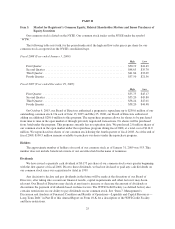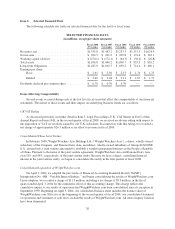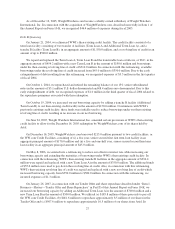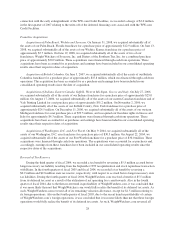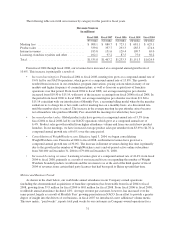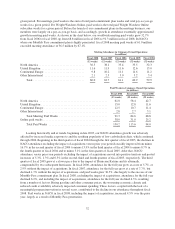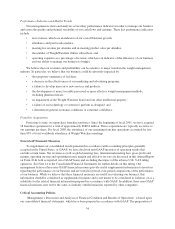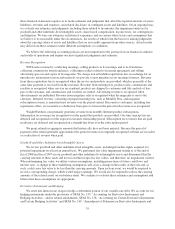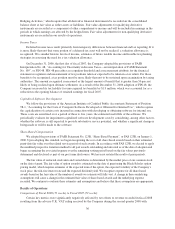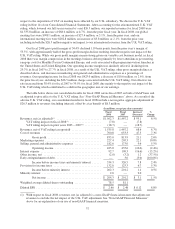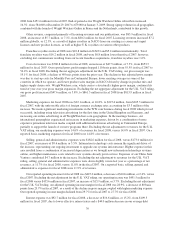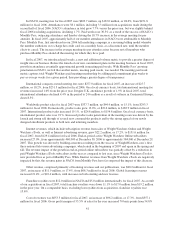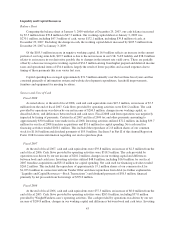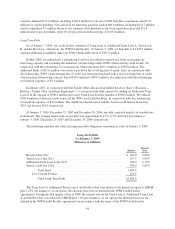WeightWatchers 2008 Annual Report Download - page 48
Download and view the complete annual report
Please find page 48 of the 2008 WeightWatchers annual report below. You can navigate through the pages in the report by either clicking on the pages listed below, or by using the keyword search tool below to find specific information within the annual report.these financial statements requires us to make estimates and judgments that affect the reported amounts of assets,
liabilities, revenues and expenses, and related disclosure of contingent assets and liabilities. On an ongoing basis,
we evaluate our estimates and judgments, including those related to inventories, the impairment analysis for
goodwill and other indefinite-lived intangible assets, share-based compensation, income taxes, tax contingencies
and litigation. We base our estimates on historical experience and on various other factors and assumptions that
we believe to be reasonable under the circumstances, the results of which form the bases for making judgments
about the carrying values of assets and liabilities that are not readily apparent from other sources. Actual results
may differ from these estimates under different assumptions or conditions.
We believe the following accounting policies are most important to the portrayal of our financial condition
and results of operations and require our most significant judgments and estimates.
Revenue Recognition
WWI earns revenue by conducting meetings, selling products in its meetings and to its franchisees,
collecting commissions from franchisees, collecting royalties related to licensing agreements and selling
advertising space in and copies of its magazine. We charge non-refundable registration fees in exchange for an
introductory information session and materials we provide to new members in our meetings business. Revenue
from these registration fees is recognized when the service and products are provided, which is generally at the
same time payment is received from the customer. Revenue from meeting fees, product sales, commissions and
royalties is recognized when services are rendered, products are shipped to customers and title and risk of loss
pass to the customer, and commissions and royalties are earned. Advertising revenue is recognized when
advertisements are published. Revenue from magazine sales is recognized when the magazine is sent to the
customer. Deferred revenue, consisting of prepaid meeting fees, such as Monthly Pass, and magazine
subscription revenue, is amortized into revenue over the period earned. Discounts to customers, including free
registration offers, are recorded as a deduction from gross revenue in the period such revenue was recognized.
WeightWatchers.com primarily generates revenue from monthly Internet product subscriptions.
Subscription fee revenues are recognized over the period that products are provided. One time sign up fees are
deferred and recognized over the expected customer relationship period. Subscription fee revenues that are paid
in advance are deferred and recognized on a straight-line basis over the subscription period.
We grant refunds in aggregate amounts that historically have not been material. Because the period of
payment of the refund generally approximates the period revenue was originally recognized, refunds are recorded
as a reduction of revenue when paid.
Goodwill and Other Indefinite-lived Intangible Assets
We review goodwill and other indefinite-lived intangible assets, including franchise rights acquired, for
potential impairment on at least an annual basis. We performed fair value impairment testing as of the end of
fiscal 2008 and fiscal 2007 on our goodwill and other indefinite-lived intangible assets and determined that the
carrying amounts of these assets did not exceed their respective fair values, and therefore, no impairment existed.
When determining fair value, we utilize various assumptions, including projections of future cash flows and
interest rates. A change in these underlying assumptions will cause a change in the results of the tests and, as
such, could cause fair value to be less than the carrying amounts. Upon such an event, we would be required to
record a corresponding charge, which would impact earnings. We would also be required to reduce the carrying
amounts of the related assets on our balance sheet. We continue to evaluate these estimates and assumptions and
believe that these assumptions are appropriate.
Derivative Instruments and Hedging
We enter into interest rate swaps to hedge a substantial portion of our variable rate debt. We account for our
hedging instruments under the provisions of SFAS No. 133, “Accounting for Derivative Instruments and
Hedging Activities,” and its related amendments, SFAS No. 138, “Accounting for Certain Derivative Instruments
and Certain Hedging Activities” and SFAS No. 149, “Amendment of Statement on Derivative Instruments and
35


